When the Water Ends
In the face of global climate change, many dry areas are getting even drier, and indigenous peoples already on the brink are feeling the heat. But what happens when the water runs dry?
“When the well’s dry, we know the worth of water.”
Ben Franklin, Poor Richard’s Almanack, 1746
Motoring through the African desert with a driver and a translator, documentary filmmaker Evan Abramson ’00 was hot on the trail of a story. Then his Jeep got stuck in the mud. Moments later, a group of local Dassanech tribesmen emerged from the surrounding environs, brandishing AK-47s and other assault rifles. The story had just come to Abramson.
The tribesmen were a few of the estimated eight million semi-nomadic agro-pastoralist people living in northern Kenya and southern Ethiopia who have learned the lesson of Benjamin Franklin’s maxim the hard way, through little fault of their own, their guns a sign of just how much the water is now worth.
They live in the lower Omo River valley and around Lake Turkana, the world’s largest permanent desert lake. It is a region that features two UNESCO World Heritage sites noted for their environmental, cultural, and archeological significance. People there survive through a combination of agriculture, fishing, and livestock herding. They move according to the availability of natural resources. In times of drought—and there have been many of late—they move with the water.
They describe the Omo River as their lifeblood. It sustains them. They depend on the river, not just directly for its water, but also for its flood cycle, which replenishes the soils and moisture of adjacent lands. The seasonal patterns of the river are changing, however, and what the indigenous population expects no longer holds true. Riverbanks that once grew lush crops now grow only kidney beans, a drought crop. During dry periods, as now, many of those riverbanks grow nothing at all. Famine looms.
Meanwhile, neighboring tribes fight over what water is left, and the land that the water supports. Often, such fights turn deadly. With global climate change, those conflicts are expected to get worse. Much worse.
It’s a topic on the minds of many. In March the Future Agricultures Consortium, a United Kingdom–based nonprofit that focuses in part on the Greater Horn of Africa, and the Feinstein International Center at Tufts University co-hosted the conference “The Future of Pastoralism” in Addis Ababa, Ethiopia. The conference theme was built around an “uncertain future” in areas “experiencing radical changes in access to key resources.” The Kenya-based nonprofit Friends of Lake Turkana puts it more bluntly, noting that “reduced access to water resources has increasingly placed local communities under intense pres- sure, leaving them constantly fighting for survival.”
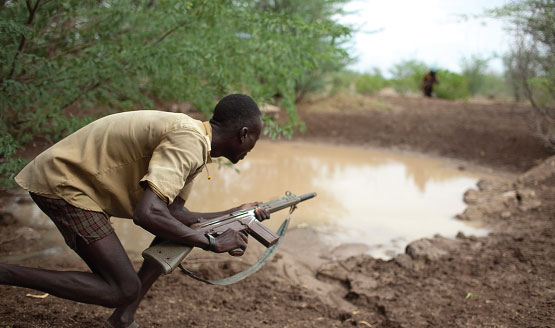
Global warming isn’t making that fight any easier. Last year (2010) was the warmest year on record since scientists began tracking global temperatures in 1850. Statistics compiled by the Economist from the three respected bodies that monitor global temperature—the Met Office Hadley Centre in the United Kingdom, and the National Oceanic and Atmospheric Administration and National Aeronautics and Space Administration in the United States—demonstrate that 9 of the 10 hottest years on record have all happened since 2001.
Looking ahead to the future, the Intergovernmental Panel on Climate Change’s Fourth Assessment Report (the most recent) predicts more of the same, with temperatures rising by as much as seven degrees Fahrenheit globally by 2100. The outlook for Africa is particularly bleak. By 2020, 75 to 250 million people will be exposed to water stress, and in some countries, rain-fed agriculture will be reduced by 50 percent. By 2080, scientists expect a 5 to 8 percent increase in arid and semi-arid lands, and droughts will expand in area, frequency, and duration.
For the Mursi, Nyangatom, Dassanech, Turkana, and other tribes of northern Kenya and southern Ethiopia, this all amounts to very bad news.
When Abramson first heard of their plight, he knew what he had to do. He set out to document and tell their story, which became When the Water Ends, a multimedia documentary released last fall. “More and more, my work is exploring, through individuals and communities, the story of the changing relationship between people and the environment around them,” he explains. When the Water Ends is “an extreme example of the negative impact of climate change on vulnerable societies.”
Abramson spent two months filming, photographing, interviewing, and traveling among eight tribes. He worked with six different drivers, and at least as many translators. It involved more than a bit of determination. The mainstream print media publications Abramson contacted passed on the story, none of them convinced it was compelling enough for their audiences. “I went out on my own and funded it myself,” Abramson says. “I had to do it on my own faith that the story would eventually be told.”
And it was. Yale Environment 360, an online multimedia magazine associated with Yale University and the Yale School of Forestry & Environmental Studies, loved it. “It was the right story at the right time,” Abramson says. MediaStorm, a Brooklyn-based studio focused on “cinematic narratives that speak to the heart of the human condition,” helped produce it. The United Nations Foundation and the Center for Investigative Reporting stepped in with funding assistance. The 16-minute documentary combined Abramson’s still photography, raw video footage from Africa, and interviews with scientists stateside.
In addition to appearing on Yale Environment 360, the film has screened this year at the Film Society of Lincoln Center’s Green Screens film series; at the annual Environmental Film Festival in the Nation’s Capital in a session titled “Displaced People, Destroyed Environments”; at the Cinemambiente festival in Italy; and at the Environmental Film Festival of Yale. Abramson has received requests to screen the documentary in England, Indonesia, Africa, and across the United States. The story is being told, the message heard.
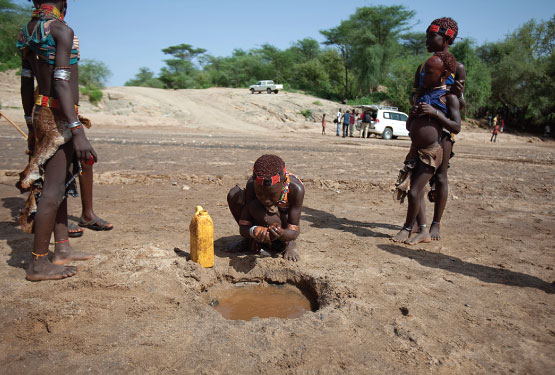
But first, there was the issue of a stuck Jeep surrounded by serious-looking men with guns. Fortunately, one of them spoke a few words of English. He and his tribesmen set down their guns and helped to push the vehicle free.
The deadly struggle over water documented in When the Water Ends is nothing new. An article in an issue of Scientific American from nearly 20 years ago recalled a startlingly similar situation concerning the Turkana tribe in Kenya in the 1960s and 1970s. It noted that they were “battered by a combination of drought and raiding by enemy tribes, armed with automatic weapons.” It was an all-too-parallel plot line.
Since the 1970s, however, the region has been slammed by drought after devastating drought. In places the soil has become like pavement. Lake Turkana has been slowly disappearing. Crops don’t grow. People go hungry. The violence, meanwhile, has been escalating.
“When I arrived at the Ethiopian border, it was like crossing into a no-man’s land,” Abramson says. “There was a tiny border post with just a few guards. The head of the guards had been killed by tribesmen the day before.” Always Abramson seemed to arrive just before or just after deadly violence had occurred. It filled his two-month visit, and the ensuing documentary, with a kind of pregnant tension, a sense of life and death constantly in precarious balance.
Many blame global warming for the shortage of water, but it’s difficult to know the exact cause, says Vassar’s Kirsten Menking, an associate professor of earth science whose courses include Paleoclimatology: Earth’s History of Climate Change. “All through the 1980s [Ethiopia] was constantly in drought,” she notes. “There was famine, people starving to death. So how do we know this is different from any other drought?” Global warming is happening, she says, and anthropogenic carbon dioxide and other greenhouse gases are making things rapidly worse. Yet, “droughts happen all the time for reasons other than global warming. Trying to pin a specific drought on global warming is tricky.”
That link is becoming clearer, however. Researchers at the United States Geological Survey and the University of California, Santa Barbara, looked at global warming’s effect on the Greater Horn of Africa, which includes Kenya and Ethiopia. They were motivated by USAID’s Famine Early Warning System (FEWS), a program designed to determine where to send food when. (During fiscal years 2008-2009, USAID sent nearly $1.1 billion in food aid to Kenya and Ethiopia.)
Their findings, published in the January 2011 issue of Climate Dynamics, were that global warming has raised the temperature of the Indian Ocean, which in turn has influenced the Walker Cell, an atmospheric circulation linking the Indian Ocean with East Africa. The result has been increased frequency of drought in that region over the course of the last 20 years, as rain falls over the ocean, leaving the winds that blow over eastern Africa bone dry. This decreased rainfall over land is especially notable during the period from March to June, a season traditionally known as the “long rains” in Kenya and the “belg rains” in Ethiopia.
Not surprisingly, both USAID FEWS and the Kenya Meteorological Department have predicted poor long rains again for this year, following on the heels of poor short rains from October to December 2010. It’s a situation that puts an estimated 17.5 million Kenyans and Ethiopians in jeopardy. This is especially true for the Turkana-Omo region, which USAID FEWS rates as “highly food insecure.”
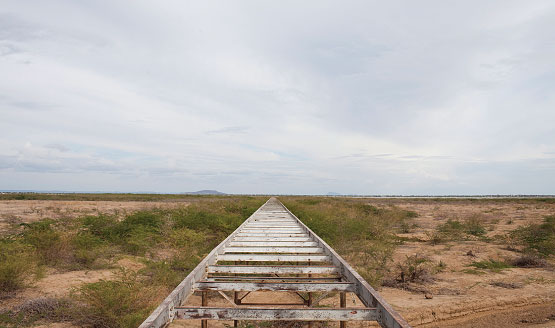
The plight of the agro-pastoralists featured in When the Water Ends inevitably raises the question of environmental justice, which deals with the inequitable distribution of environmental burdens. “What you see is a kind of human suffering among people who had no hand in the creation of global warming,” says Peter Stillman, Vassar professor of political science. He teaches a variety of environmental studies courses on topics such as environmental political thought, environmental justice, and the inequitable distribution of water. “They are innocent victims and obvious candidates for some kind of recompense.”
Global warming is caused by greenhouse gases. Anthropogenic carbon dioxide is chief among them, released primarily through the burning of fossil fuels and secondarily through deforestation. “Atmospheric CO2 concentrations have now hit 390 parts per million (ppm),” notes A. Marshall Pregnall, an associate professor of biology at Vassar whose courses have included History of Global Climate Change.
A common threshold in climate change science is 350ppm atmospheric carbon dioxide, a concentration that is considered the “safe” limit. Present levels are higher than they’ve been in 650,000 years or more and represent an exponential increase since the start of the Industrial Revolution, when atmospheric CO2 levels were the same as they’d been for some 10,000 years. “There’s no question we’re pumping huge amounts of CO2 into the atmosphere,” Pregnall says. “We’re in uncharted territory.”
According to the Earth Policy Institute and an overwhelming consensus of the international scientific and governmental community, the developed world is the main culprit, with the United States and a handful of others leading the pack. For example, in 2007, the U.S. alone emitted more than 6 billion metric tons of CO2, with a per capita rate of 19.9 tons per year. In that same year, Kenya and Ethiopia together accounted for just 17 million tons, with respective per capita rates of 0.3 and 0.1 tons per year.
“These are people already vulnerable and ill equipped to deal with environmental changes; this makes their existence all the more precarious,” says Joseph Nevins, Vassar associate professor of earth science and geography. His courses include Earth Science and Society, which focuses on the challenges presented by climate change and resource conflicts, including the distribution and use of water. “There are implications for our immediate behavior, as well as for climate change reparations,” he says. “If we’re going to export the negative environmental consequences of our behavior, from a justice standpoint, from a moral and ethical stance, that’s the perspective we have to take.”

Governments are starting to take note of just that. At the United Nations Framework Convention on Climate Change held in Cancun, Mexico, in 2010—which Vassar student Ethan Buckner ’13 attended as part of the Sierra Club Student Coalition—nations agreed not only to more aggressive carbon emissions reductions, but also to “fast-start climate finance pledges,” whereby richer nations send money to poorer nations to begin to pay for the price of climate change and to help those nations better cope. Eventually, those funds will take shape as the Green Climate Fund, to which 40 richer nations will contribute $100 billion annually.
For now, according to the World Resources Institute, $29 billion has been collectively pledged for 2010-2012, with less than $7 billion actually delivered so far. Critics have called it a drop in the bucket compared to the scale and scope of the problem. In the meantime, though, the situation on the ground remains the same. Global climate change is getting worse and water resources in the Turkana-Omo region are scarce. Together, they are a sure harbinger of escalating deadly conflict.
Water scarcity in the region has also given rise to conflict of another type, that of a power struggle between Ethiopia and Kenya for control of the Omo River, which runs south through Ethiopia into Lake Turkana in Kenya. Since the early 1970s, Lake Turkana, which once spanned those country’s borders, has retreated almost entirely into Kenya. “People can no longer get water from places they traditionally got it,” Stillman explains. “They have nowhere else to go.” Ethiopian tribes have been moving south into Kenya, following the water—and fighting with Kenyan tribes. In places, some Kenyans find themselves displaced refugees within their own country. In late spring 50 Turkana tribesmen were killed at the same Ethiopian border Abramson crossed last year.
At issue is Ethiopia’s planned Gibe III dam on the Omo River. Lake Turkana gets some 90 percent of its water from the river, and Ethiopia has ambitious—some would say, audacious—plans to dam the river and retain its water before it ever gets to Kenya. According to the Guardian, it is the largest infrastructure project in Ethiopian history, and the largest hydroelectric project in sub-Saharan Africa. Ikal Angelei, the director of Friends of Lake Turkana, has another take on it, calling it “the most outrageous social injustice of our time.”
The controversial Gibe III dam isn’t the only time Ethiopia has threatened a neighbor with withholding water. As recently as April 2011, Ethiopia and Egypt nearly came to blows when Ethiopia similarly threatened to dam the Nile.
Examples abound beyond northeast Africa, too. Pregnall points to Iraq, which once had a very large wetland system in the southern part of the country. “The water leading into that area only got dammed up in order to squelch the semi-nomadic people who lived down there,” he says. Stillman notes that China is busy building dams along the Mekong River, threatening downstream countries such as Vietnam and Cambodia. Menking cites ongoing tensions between the U.S. and Mexico over the waters of the Colorado River (where Stillman and Jeff Walker, Vassar professor of earth science and geography, led a field trip course simply titled, Dry, about water in the arid American Southwest).
“Water is the new oil in terms of both importance and conflict,” Stillman says. “Shortages are producing conflicts in places where they hadn’t existed before.” “Rivers don’t obey political boundaries,” Menking adds. Neither does global warming.
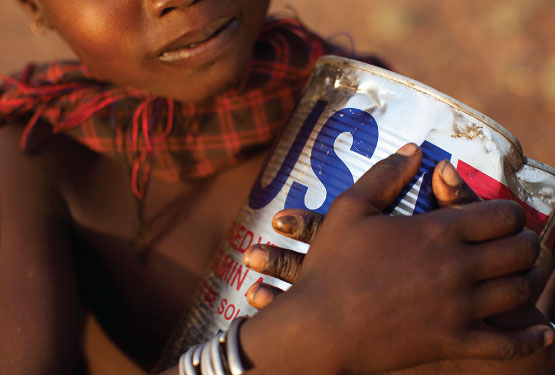
Because the Gibe III project has drawn criticism from around the world, Ethiopia has clamped down on journalists covering the topic and entering the country to visit the lower Omo River valley region. It made for tenuous circumstances for Abramson. Once he crossed from Kenya into Ethiopia, he had to keep a low profile and try to avoid rousing the suspicions of authorities. He largely succeeded until the eleventh hour.
When he returned to Kenya from Ethiopia, border guards and the Ethiopian police detained him for more than six hours. They insisted on seeing his photographs and demanded that he erase his videos and the hard drive of his computer. “That was the worst part of the trip,” Abramson recalls, “when I thought I was going to lose everything.”
He had smartly hidden compact flash cards from his camera in his underwear. The guards—unfamiliar with Abramson’s Mac laptop—were unable to locate his archived videos. He browsed quickly through photos, pausing only on the more “tourist-y” shots to convince them he was nothing more than a traveler off the beaten track. They let him pass, his photos and video footage intact.
Scientists and social scientists such as Menking, Pregnall, and Nevins point out that global warming isn’t the only factor influencing water scarcity in a place such as the lower Omo River valley, nor the only reason Lake Turkana is drying up. As in the atmosphere itself, or in nature, there is a complex web of interactions, including population growth, the expansion of irrigated agriculture, the demands of industry, the development of the undeveloped world, and the adoption of a more consumptive, modernized, “Western” lifestyle in places that previously had little environmental impact.
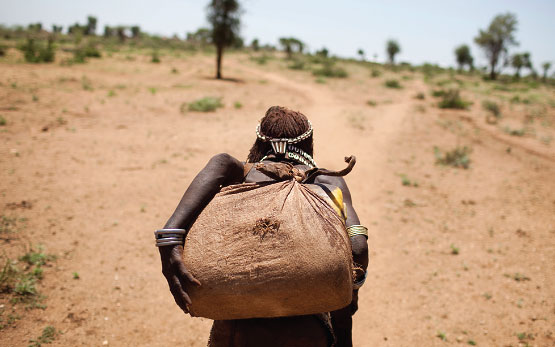
Nevertheless, global warming remains perhaps the most daunting influence. “Things are changing faster than our models predicted,” explains Pregnall, pointing especially to the Arctic, where the melting of polar ice has far outpaced scientists’ expectations. “It’s easy to get very grim,” he continues. “Atmospheric scientists are really scared. They tend to be fairly sanguine people. But they trust the outputs of their models, know how robust they are, run them forward in time, and go ‘Whoops! That’s way beyond anything we’ve seen.’ We’re headed to a world outside the range of our data set. We’ve never seen these potential consequences. Just consider that the Dust Bowl, which displaced millions of people and modified U.S. history, took place in a relatively small place on one continent.”
“There’s an idea of planetary thresholds,” adds Menking. “These are tipping points beyond which the system changes states. We’re edging toward the top of the roller coaster before things change really, really fast. Some of the changes we’ve been seeing, such as in the Arctic sea ice, suggest we’ve already crossed a threshold for climate change.”
This probability makes the message of Abramson’s When the Water Ends all the more pressing. Inspiring action first starts with building awareness, the documentarian says. “Many indigenous cultures are becoming swallowed up by the globalization of societies around the world. These people depend the most on natural resources for their daily life,” he concludes. “I’m trying to provoke people to rethink their relationship with the environment and how they use natural resources. We can all relate to climate change.”
Day to day, the effects of that climate change may not seem as immediate or as dramatically life-and-death as when the Mursi and the Dassanech and other tribes kill one another over scarce water in East Africa. But we are all feeling the heat, Abramson says, and we all need to do something about it, before the water runs dry.
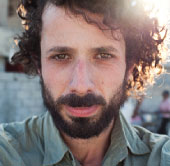
The work of photographer Evan Abramson ’00 has appeared in the Atlantic, National Geographic Adventure, New York Times, Los Angeles Times, and Washington Post. He is also a documentary filmmaker. Most recently, his documentary narratives have explored themes of environmental and social crisis in the context of water and indigenous peoples. Following When the Water Ends, he focused his lens on southern Louisiana for the work-in-progress, Last Stand on the Island.
